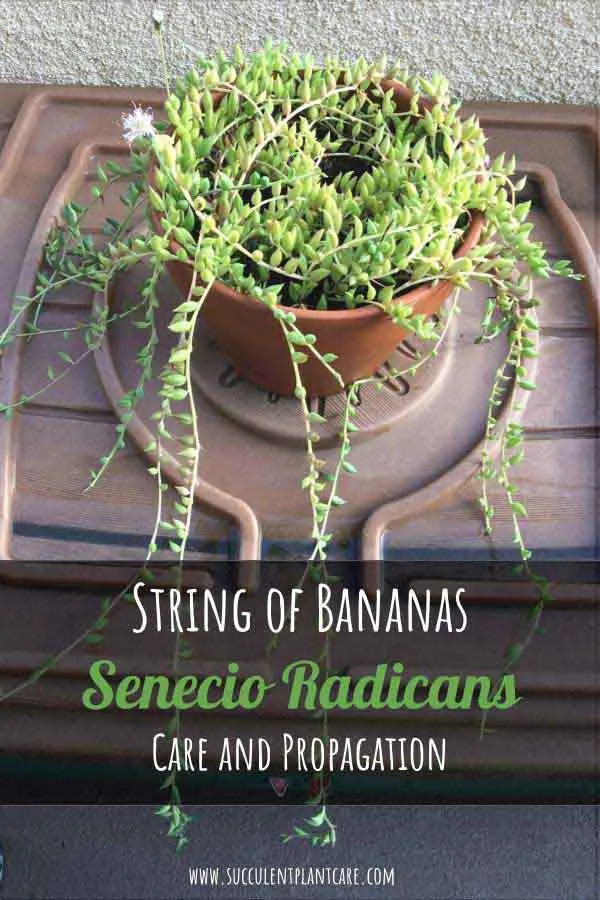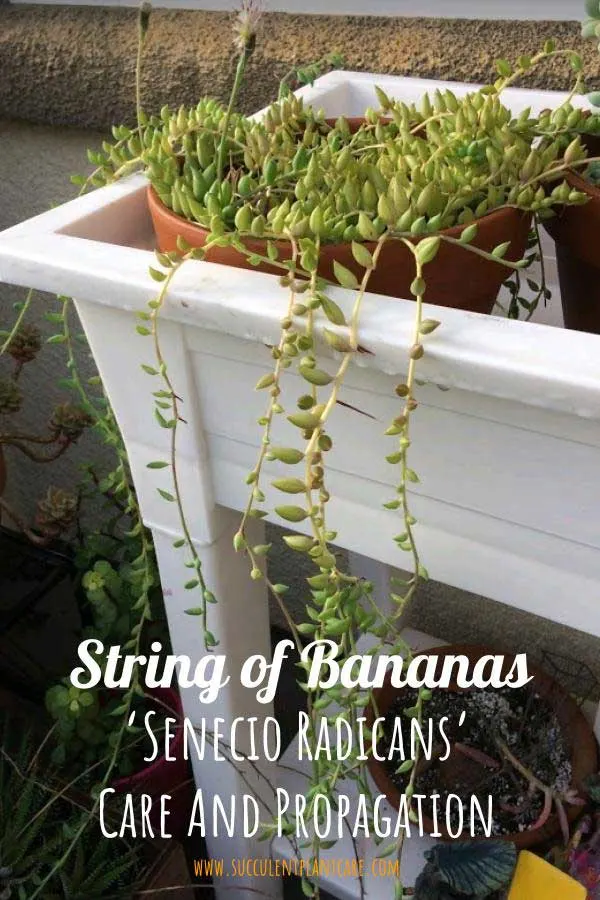Senecio Radicans ‘String of Bananas’ are native to South Africa where they grow on the ground along with other vegetations as ground cover. These are fast growing succulents with stems that can reach 3ft (90cm) long. Succulents are well adapted to survive in dry, arid conditions and String of Bananas are no exception.
They can store water in their stems and in the plump, banana shaped leaves. These plants are not frost tolerant and need protection from freezing temperatures and also intense heat. They have green leaves that are shaped like mini green bananas, which gives them their common name. Could they get any cuter than that?

Due to their creeping nature, in cultivation they are popularly used as ornamental plants. You can often see them in hanging baskets, or cascading down a tall planter, or trailing from all sorts of arrangements. They can also be grown as ground cover but we don’t see this as much.
Their stems creep and grow like vines. They produce small white, yellow or lavender fuzzy flowers similar to String of Pearls. The flowers have a sweet spiced-cinnamon scent. The stems can be cut and propagated. When cut, the stems will split into two or more and keep on growing.
String of Bananas anyone? I think it’s time to pay attention to these beauties that have been playing second fiddle to it’s more popular relative, the String of Pearls. I for one am guilty of ignoring this equally noteworthy plant and paying way too much attention to my String of Pearls.
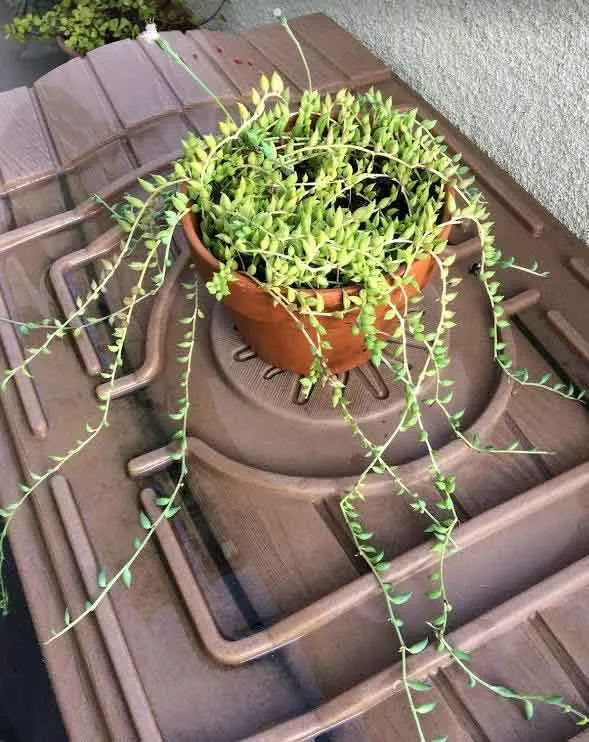
I couldn’t help myself. How could you resist those gorgeous, plump, round leaves and long, trailing stems…OK, I have to stop or I could go on and on. And I did on these posts, “String of Pearls Care and Propagation”, plus “Why Are My String of Pearls Shriveling?” and “How to Save a Dying String of Pearl Plant” so do check them out for very important tips, useful information and fun details.
Enough about these String of Pearls because what I have in front of me is just as beautiful and enticing, and you did not hear this from me: but they are also easier and hardier than String of Pearls–these are the String of Bananas Plant ‘Senecio Radicans’.
It’s about time for String of Bananas to take center stage.
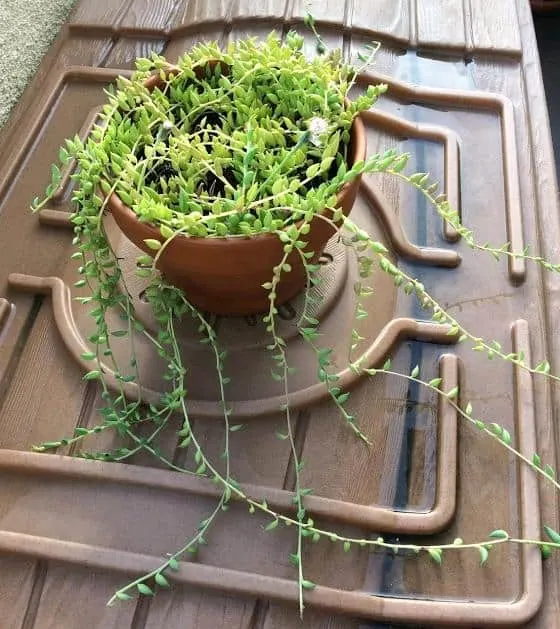
Are They Indoor or Outdoor Plants?
String of Bananas can be grown both indoors and outdoors. Whether indoors or outdoors, provide the right potting mix (a well draining one) to give them the best chance at survival.
Outdoor Sunlight Requirements
String of Bananas need plenty of bright sunlight but they also need to be protected from intense heat or full sun. They do well in a bright but partially shaded area, or in planters shaded by other taller plants. Typically speaking, bright morning sun is well tolerated and preferred as opposed to the more intense afternoon heat.
Before moving the plant outdoors or increasing the amount of sunlight it receives, it is better to acclimate the plant to prevent sunburn. Slowly increase the amount of light the plant receives to get it acclimated to the more intense light. This will help prevent sunburn or sun damage.
Keep in mind that even when the plant is already acclimated to the sun, you still need to provide sun protection or shade during a heatwave or intense heat. Sunshades are a real lifesaver for my plants during the intense summer heat here in Northern California where the sun can really scorch the plants if left unprotected. Here are some of my recommendations for sunshades and sun protection.
Unlike its close relative the String of Pearls which are very sensitive to intense heat, I find String of Bananas to be more tolerant to heat. This is one of the reasons why String of Bananas are easier to grow. I have been able to acclimate some of my String of Bananas Plant to grow in full sun.
However, I do not recommend doing this if you are just starting out with this plant. It is best to provide as much bright light as possible but protect from intense heat or full sun to ensure survival.
For further details and information on outdoor sunlight requirements, please visit my post “How Much Sunlight Do Succulents Need Outdoors?” to get some useful tidbits.
Indoor Lighting Requirements
If kept indoors, provide as much light as possible. In general, they need approximately 5-6 hours of light per day to thrive. If you live in an area that does not receive adequate light indoors or if you have poor lighting, consider using a growlight.
Growlights are a good investment to have especially if you you have long, dark winters or if your area does not receive enough sunlight. Here are some of my grow light recommendations.
Choose an east facing window if possible. A south or west facing window will also work. If kept next to the window, bright direct sunlight may burn the plant. If you notice this happening, simply move the plant to another spot or move a few inches away from the window. You may also consider providing sunshade to prevent sunburn.
To read more about this topic on indoor lighting for succulents, check out my post on “Proper Lighting for Succulents Indoors” to get some helpful tips.
Frost Tolerance
Keep in mind that String of Bananas are not frost tolerant plants and would need protection from freezing temperatures. I am lucky to live in sunny California where winters are mild compared to other areas.
We do get frost and the temperatures do drop below freezing at times but I am able to keep my String of Bananas outdoors all year long.
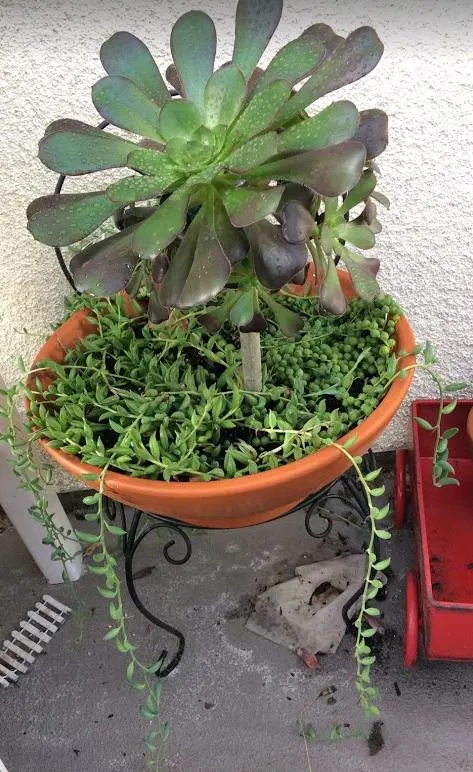
They do tolerate mild frosts but will not tolerate long periods of below freezing temperatures or harsh winters. If kept in containers, bring indoors if frost is expected or before winter sets in. If planted in the ground, provide protection from freezing temperatures using frost cloths and greenhouses. These frost cloths and greenhouses can save your plants and protect them from the long, harsh winter months.
For more information on this topic, do visit my post on “Optimal Temperatures for Succulents to Thrive”.
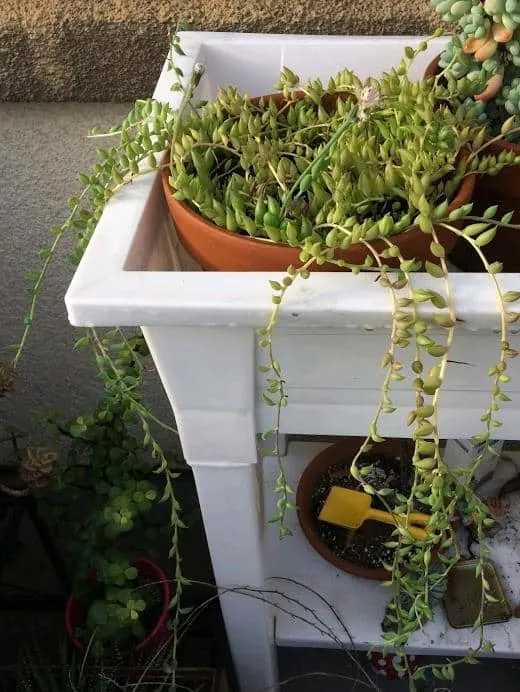
Soil Requirements
Just like with other succulent plants, String of Bananas need well-draining soil. For convenience sake, I like to use a cactus potting mix combined with perlite for more drainage. I do not use exact measurements but eyeball it to about 2:1 solution of cactus mix and perlite. Others recommend using sandy soil. This can be achieved by mixing cactus mix or potting soil with coarse sand (about 2:1 ratio). I get most of my materials from a local hardware store. If you are wondering where to purchase them online, check out my resource page for helpful recommendations. I have also written a very informative article about the best soil and fertilizers for succulents. You can read more about it on “Best Soil and Fertilizers for Succulents”.
Watering Recommendations
Watering largely depends on the climate you live in. There really isn’t a set schedule or formula on when to water succulents. I live in a very dry climate so my watering schedule is adapted to the dry conditions of my environment. In the summer months, I water my String of Bananas every 7-10 days, sometimes more during a heatwave, giving the plant a good drink.
I cut back on watering to about 10-14 days when the weather cools down. If you live in a humid location, you won’t need to water as much. During the winter season, I mostly rely on rainwater and hold back on watering altogether because this is when we get a lot of rain in my area. But if we don’t get any rain at all during winter then I water at least once a month or every 2-3 weeks.
One good way to tell whether it’s time to water is to check the moisture of the soil. The top inch of the soil needs to feel dry before you can water again. If you are unsure how much and how often to water in the beginning, it’s always better to underwater and increase watering as needed. Pay attention to how your plant looks and you can adjust watering accordingly.
Watering Techniques
Along with watering habits, pay attention to your watering techniques. I do not like to mist mature plants. If you are misting instead of watering, the plant may not be getting enough water because the water may not be reaching the roots of the plant where the water needs to go to be absorbed. I give my String of Bananas a good drink of water and leave them alone until it is time to water again. In fact, I let them stay a little on the dry side.
Don’t be afraid to give the plant a good drink of water, let the water reach the roots of the plant so the plant can absorb it from the root up. The more mature and established the plants are, the more water they can store in their leaves and the less often you need to water. But when you do, water deeply and give it a good drink and then do not water again until it is dry.
If you need further help with watering techniques, consider using tools like hygrometers or moisture meters to check for moisture in the soil and air. These tools are pretty affordable and can come in handy especially if you are unsure of when to water your plant next. Do check out these tools if you need help in gauging your watering needs.
Interested in finding out more about watering succulents? Visit my post “How And When To Water Succulents” where I go into details about this topic.
Are You Overwatering or Underwatering?
The best way to tell whether your String of Bananas are over or underwatered is by paying attention to how the leaves look. The easiest way to tell if your plant is underwatered is when the leaves start shriveling. When this happens, it is usually a sign that the plant is running low on its water storage and it is time to water. If this is the case, give the plant a good drink and it should perk up within a day or so. It is easier to ‘fix’ an underwatered plant than an overwatered one.
If the plant starts looking unhealthy, becomes soft and mushy and may even burst when touched, these are telltale signs that you are overwatering your String of Bananas. These plants have storage capacities in their stems and leaves and if you overwater them, they can literally burst from too much water. If this is the case with your plant, don’t worry.
The first thing you need to do is to stop watering your plant. Give it a chance to dry out and the plant will usually bounce back. If the soil is not drying out fast enough and stays wet for long periods of time, it is a good idea to repot the plant in a well draining potting mix. If the plant does not recover from overwatering and starts to rot, you can still save the plant by removing it from the wet soil, remove any dead or rotten parts, save any green parts and let them dry out for a few days then repot in a well-draining potting mix.
Pay attention to your watering habits. How often are you watering your plant? If you water once a month or less and you notice your String of Bananas are shriveling, they are clearly being underwatered. If however, you have been watering your plant regularly about once a week and you notice the plant looking sick, discoloring and becoming mushy, chances are the plant is receiving too much water. For more on this topic, visit my post on “How To Tell If Your Succulents Are Over or Under Watered.”
Why Do String of Bananas Turn Brown?
The most common reason String of Bananas turn brown is from sunburn or sun damage. If you notice your String of Banana leaves turning brown, looking shriveled and dry, the plant may be suffering from too much sun exposure. Move to a shadier location or provide sun protection against intense light or full sun.
Along with sunburn, the plant may also be dry and underwatered and is turning brown and shriveling. Give the plant a good drink of water and it should perk up. Unfortunately, sun damaged brown spots are usually permanent and do not go away.
You just need to wait for the plant to produce new green growth and the plant will eventually shed old leaves and get rid of the brown spots. If you are really bothered by how they look, you can trim them off and the plant will re-grow new stems.
String of Bananas can also turn brown, become mushy and then turn black from rot. This usually happens when the plant is being overwatered. The plant starts rotting from the crown up. If this is the case with your plant, save any viable green parts to replant and propagate and discard the dead parts. Make sure to plant in a suitable well-draining potting mix and avoid overwatering.
How To Propagate String of Bananas
Stem Cuttings
String of Bananas is really easy to propagate. The most common and easiest way to propagate String of Bananas is through stem cuttings. The plant roots from the stem and can root anywhere along the stem.
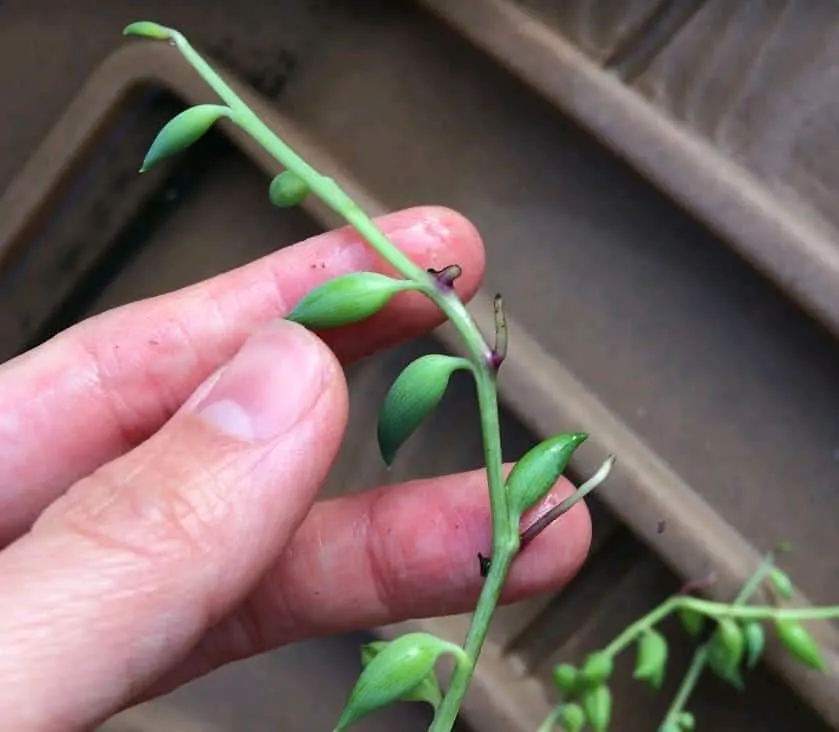
The plant roots anywhere along the stems
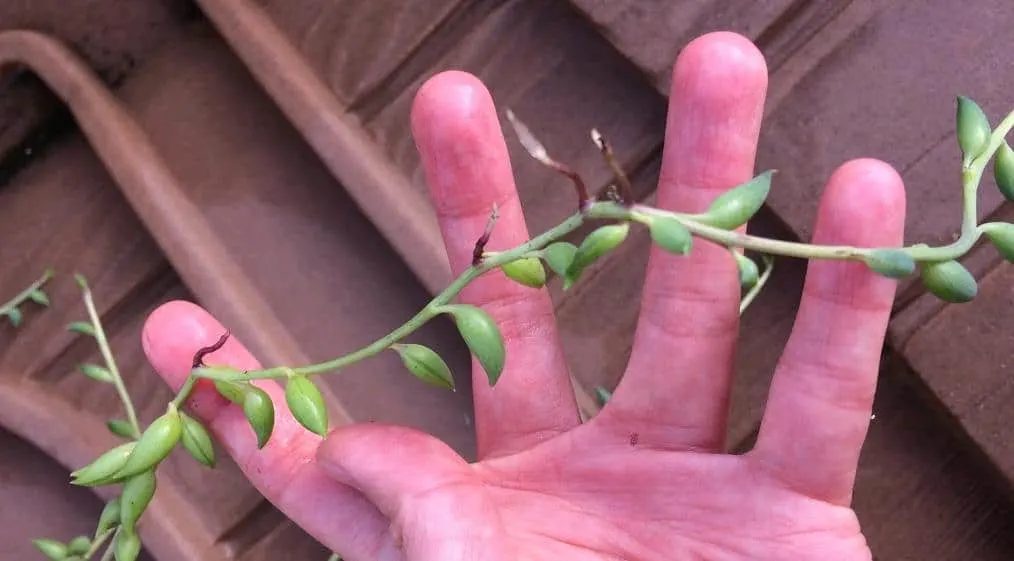
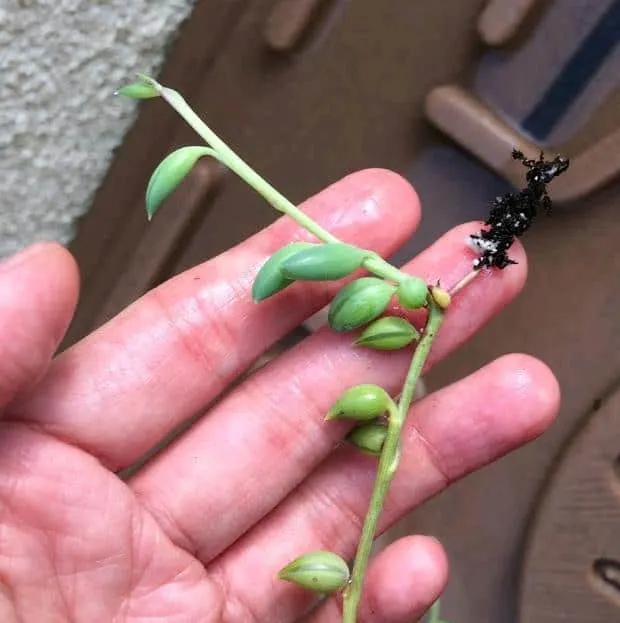
These stems have rooted where it was touching the soil from another pot.
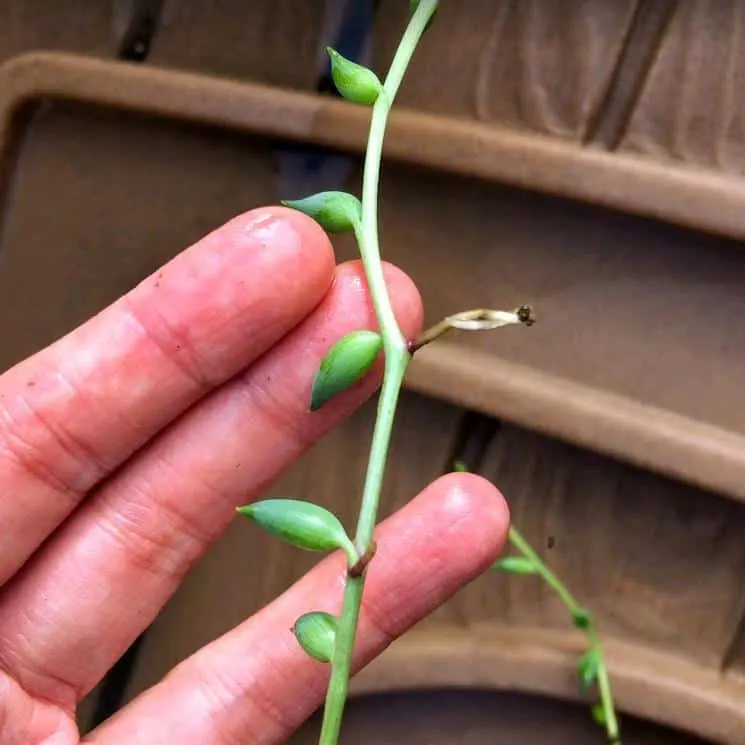
The Stem Propagation Steps Are As Follows:
- Choose a strand you want to cut. It is better to cut from mature stems.
- Take a few stem cuttings. Unlike other succulents, the stem of String of Bananas are thin so you do not have to wait for the stems to dry. Let it sit for a couple of hours to about a day and this is sufficient enough.
- Prepare a well-draining potting mix. Once dry, stick the cuttings in soil. You can also lay the cuttings flat on the soil.
- Wait for the plant to root and new growth to develop. This can take anywhere from 2 weeks or longer.
- Keep away from direct sunlight to prevent sunburn while propagating and rooting the cuttings.
- Mist every few days or when the soil feels dry. Once rooted and more established, stop misting and switch to watering the plant. You can decrease the frequency of watering to about once a week or less when mature.
I do it slightly differently and it has worked out for me quite nicely. What I do with the stem cuttings is I lay the cuttings sideways on the soil. This way I start out with a fuller top and eventually have the plants trail. It may take longer for them to trail this way but you end up with a full top and a plant that’s trailing. The plant shoots out roots from anywhere it touches the soil. If you do not want to wait and want yours to trail or hang right away, then do the other method of sticking the end in soil and the plant will continue to grow and trail.
This is the only way I propagate String of Bananas. I have not had any success rooting or propagating from the little banana-shaped leaves. I would imagine it will take a lot longer to propagate from leaves but hey, anything is possible so I wouldn’t be surprised if some people have had success propagating this way. For me, it is easy and fast enough to propagate from stems so it is my preferred and only method.
For more on String of Bananas propagation, visit my post on “3 Ways to Propagate String of Pearls and String of Bananas.”
Blooms From String of Bananas
String of Bananas produce small, white fuzzy flowers that have a sweet cinnamon-vanilla spiced scent. Some people think these flowers are small and unremarkable. But I always get a kick out of these blooms. I find them very pretty and love seeing and smelling these white fuzzy flowers. They truly are a treat and always brighten my mood.
Before anything else, do realize that not all plants will bloom. Environmental factors beyond our control play a huge part in whether or not your plant blooms.
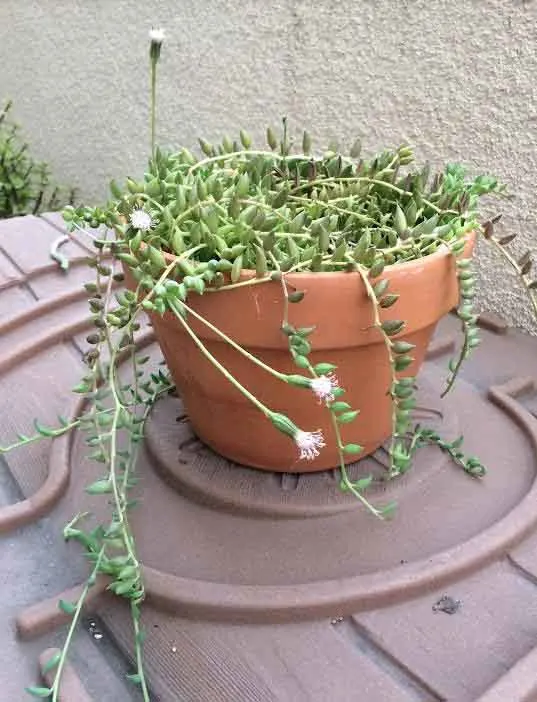
How to Encourage String of Bananas to Bloom
Plant Maturity
Make sure the plant is mature enough to bloom. When a plant blooms it means it is ready to reproduce. If the plant is too young, it is simply not ready to reproduce and therefore will not bloom. Give the plant some time, usually if the plant is over 2 years old and beyond, it is ready to bloom.
Proper Temperatures
To encourage flowering, provide proper temperatures. They need a distinct difference in night and day temperatures as well as summer and winter months. Succulents favor cooler outdoor nighttime temperatures of 50-55⁰F (10-13⁰C) or indoor night temperatures of at least 60-65⁰F(15-18⁰C). Especially when kept in a controlled environment, succulents prefer a marked difference between their night and day temperatures to mimic their natural habitat, with the cool night temperatures having an integral part in the plant’s growth cycle.
Overwintering
Overwintering is also important if you want to see your succulents bloom. This can be achieved by keeping them cool and relatively dry in the winter months, especially desert cacti. Keep them cool during winter months with temperatures just above freezing, between 35-44⁰F (1.5-7⁰C). If kept indoors during winter, have them in a non-heated room if possible or keep the temperatures low to provide them the cold winter period that they need.
Plenty of Light
Make sure the plants are receiving adequate sunlight throughout the year and are kept in a bright location, even during colder winter months. Most cacti and succulents need at least 5-6 hours of bright light or more.
Feed or Fertilize
While fertilizing is not necessary, giving your plants the nutrients they need will help ensure proper growth and encourage blooms. It takes a lot of energy for plants to produce flowers, and feeding them extra nutrients will help supplement their needs during the flowering season. The most common recommendation is to fertilize during the active growing season, or during spring and summer months. Fertilizers are better applied at a quarter or half strength, about every two weeks. Refrain from fertilizing towards the end of the fall season and during winter months. A balanced blend of fertilizer diluted to half strength is suitable and commonly used. Fertilizer blends specially formulated for cacti and succulents are also suitable. Here are some of my fertilizer recommendations.
String of Bananans Toxicity to Cats, Dogs or Pets
While its cousin Senecio Rowleyanus ‘String of Pearls’ is known to be mildly toxic to cats, dogs and other pets, there isn’t any known information on the toxicity of String of Bananas. The ASPCA website does not list String of Bananas as toxic to pets. Since they are closely related to String of Pearls which are known to be mildly toxic, err with caution when bringing this houseplant home to pets. If you suspect poisoning, contact your local veterinarian immediately or the ASPCA Animal Poison Control Center at 888-426-4435.
There you have it. This is a complete guide on how to care for String of Banana Plants. They are easy, fun and definitely worth the effort. The rewards you get in return will be priceless. So if you are looking for a trailing plant that is easy to care for, or you have tried growing String of Pearls but have had no luck, give String of Bananas a go and you truly would not be sorry.
Where can you find Senecio Radicans ‘String of Bananas’? Check out my resource page for recommendations on where to purchase these and other succulent plants online.
Pin this now to save for yourself or share with others!
